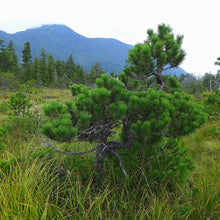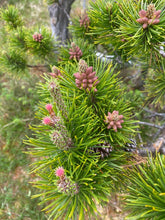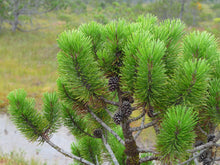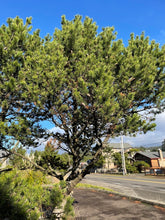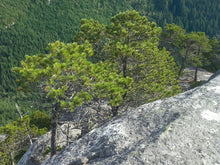
Pinus contorta ssp. contorta
Shore pine’s compact size, evergreen needles and all-around durability make it an excellent choice for urban and suburban gardens. Its Latin name is derived from the way coastal winds scalp this species into dramatically contorted designs. Its thick, sculptural branches are adorned with short, dark green needles that cover the stems in bundles of two (Pinus contorta is the only species of pine native to the Pacific Northwest with this feature) and provide excellent habitat for many species of wildlife. It also performs beautifully in a container on patios or balconies.
- Plant type/canopy layer: evergreen, perennial, large shrub or small tree
- Size at maturity: 9-50' tall, 20-45' wide (rarely more than 30’ in garden settings)
- Light requirements: full sun, light shade
- Moisture requirements: dry to wet soil
- Bloom time: May-July
- Growth rate/ease: fast growing, easy to grow
- Wildlife support: needles are a critical source of food for porcupines in winter; all plant parts are eaten extensively by pine beetles, which in turn are a plentiful food source for bushtits, kinglets, chickadees, and woodpeckers; seeds are eaten by chipmunks, squirrels, grouse, crossbills, grosbeaks, chickadees, band-tailed pigeons, quail, mourning doves, jays, nuthatches, finches, and siskins; overall plant is a preferred roosting and nesting site for songbirds nest, attracts and supports hummingbirds, beneficial and pest eating insects and is believed to be a caterpillar host plant and larval food source for around 50 species of native butterflies and moths
- Native habitat/range: commonly grows in a wide variety of habitats from coastal dunes, bluffs, and peat bogs, dry mountain forests and foothills, to maritime fog forests, from sea level to around 600m, from the Pacific coast of Alaska to northern California. Portland Plant List - no.
-
Special features & uses: wildlife favorite; evergreen; drought resistant; deer resistant; according to the Washington Native Plant Society, this species has been used by indigenous people for thousands of years;
- Material Uses: The Nisgaa have used the roots for rope. The Haida have used peeled sheets of bark as splints for broken limbs. The pitch has been used by the Sechelt to waterproof canoes and baskets, by the Saanich to fasten arrowheads onto shafts, and by the Lower Stlatlimx as a glue and to provide a protective coating for Indian-hemp fishing nets.
- Medicinal Uses: The pitch and bark have been used medicinally by the Coast Salish, Nuu-chah-nulth, Kwakwakawakw, Nuxalk, Haida, Tsimshian, and Tlingit. The gum has been applied to cuts or as a poultice for heart pain and rheumatism, or made into a tea for tuberculosis.
- Current landscape uses include rock gardens, raingardens and pollinator gardens, erosion control and bank stabilization, habitat hedgerows, as well as wide privacy screens and windbreaks
- Material Uses: The Nisgaa have used the roots for rope. The Haida have used peeled sheets of bark as splints for broken limbs. The pitch has been used by the Sechelt to waterproof canoes and baskets, by the Saanich to fasten arrowheads onto shafts, and by the Lower Stlatlimx as a glue and to provide a protective coating for Indian-hemp fishing nets.
Gardening with Shore Pine: The combination of tremendous adaptability and high habitat value make shore pine a desirable choice for habitat gardens. Simply be sure to give this species adequate sunlight and it should get along just fine. That said, it will grow best in deep, well developed soils that receive some moisture and have adequate drainage. It can be planted in groups, or mixed with other native evergreen species to provide a privacy screen or windbreak - or simply add one as a statement piece and habitat refuge in your sunny rock garden or woodland edge. It has intermediate water needs, but prefers to dry out between waterings. Rainwater is typically enough once established, except perhaps in particularly intensely long bouts of summer heat. It is largely tolerant of drought, salt spray and generally deer resistant.
Photo Credits 1 & 3 (needles/cones, in a bog): © icosahedron, some rights reserved (CC-BY)
Photo Credit 2 (flowering): © Suzanne Carriere, some rights reserved (CC-BY)
Photo Credit 4 (roadside): © Joseph Rojas, some rights reserved (CC-BY)
Photo Credit 5 (mountaintop): © Riley Pollom, some rights reserved (CC-BY)





